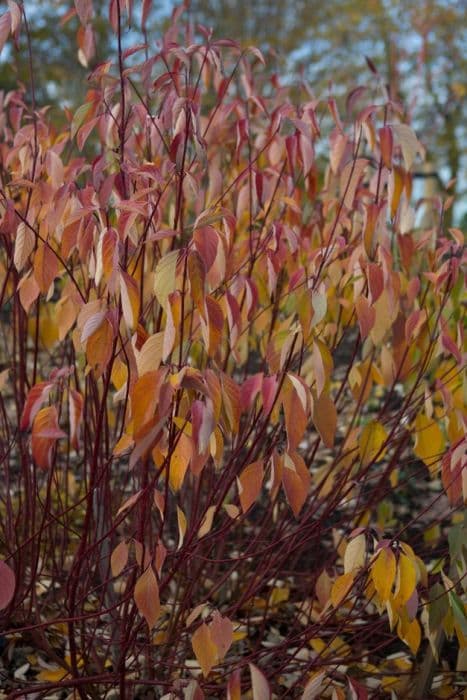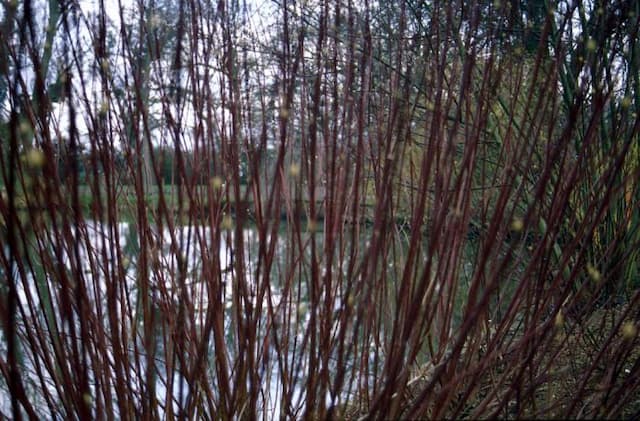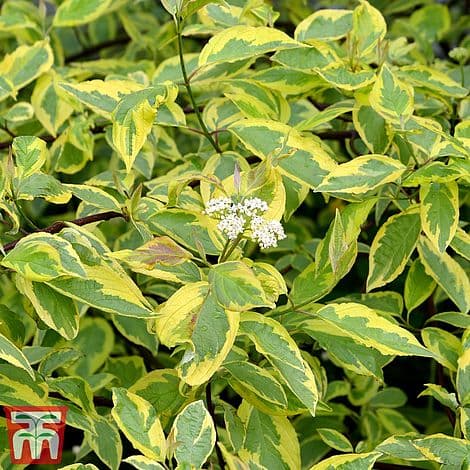Cornus kousa 'Miss Satomi'











ABOUT
Miss Satomi is a variety of the common name kousa dogwood, known for its striking features and ornamental beauty. In spring, it becomes a centerpiece in the garden with its abundant floral display, boasting large, star-like blooms. These are not true flowers but modified leaves called bracts that surround the tiny central flowers. The bracts of Miss Satomi are distinctive with their deep pink color, which can vary in intensity depending on different factors, including weather. As summer comes, the foliage of Miss Satomi provides a lush backdrop of green leaves that are pointed and oval with visible veining. The leaves have wavy edges and provide a dense canopy, making the plant an excellent choice for adding green texture to the landscape. In the transition to autumn, Miss Satomi's leaves take on yet another persona, displaying a spectrum of colors. They can turn into shades of red and maroon, adding a warm, vibrant display to the fall garden. Not only does Miss Satomi offer seasonal foliage interest, but it also produces ornamental fruit that can attract birds and wildlife. These fruits resemble tiny, bumpy berries and start out green, turning to a pinkish-red hue as they mature. Adding to its year-round beauty, the bark of Miss Satomi exfoliates with age, revealing a mosaic of tan, gray, and brown, which gives the structural interest in the dormant season. Overall, Miss Satomi's appearance carries a sense of elegance and dramatic flair through each season, distinguishing it as a favored ornamental plant in many gardens.
About this plant
 Names
NamesFamily
Cornaceae.
Synonyms
Kousa Dogwood, Japanese Dogwood, Chinese Dogwood, Korean Dogwood.
Common names
Cornus kousa 'Miss Satomi'.
 Toxicity
ToxicityTo humans
The Kousa dogwood, specifically the cultivar 'Miss Satomi', is considered non-toxic to humans. In fact, the fruit of the Kousa dogwood is edible and sometimes used for making wine or jelly. However, the fruit might not be palatable to all individuals and might cause mild stomach upset if consumed in large quantities due to its fibrous nature. There are no serious toxic effects reported from ingesting the leaves, bark, or flowers of this plant. Always practice caution and consult with a medical professional if any adverse reactions are observed after ingestion.
To pets
The Kousa dogwood, specifically the cultivar 'Miss Satomi', is generally regarded as non-toxic to pets. This includes common household pets such as dogs and cats. The fruit of the dogwood is considered edible and is not known to cause any significant toxic effects. However, as with any non-typical food items, consumption of the plant material may potentially cause mild gastrointestinal upset in some pets, such as vomiting or diarrhea, particularly if consumed in large quantities. If any such symptoms are observed, it is advisable to consult a veterinarian.
 Characteristics
CharacteristicsLife cycle
Perennials
Foliage type
Deciduous
Color of leaves
Green
Flower color
Pink
Height
8-12 feet (2.4-3.7 meters)
Spread
8-12 feet (2.4-3.7 meters)
Plant type
Shrub
Hardiness zones
5-8
Native area
Asia
Benefits
 General Benefits
General Benefits- Ornamental Appeal: The Kousa dogwood 'Miss Satomi' is prized for its deep pink to reddish floral bracts that enhance garden aesthetics.
- Four-Season Interest: This plant offers year-round visual interest from spring flowers to summer fruits, autumn-hued leaves, and textured winter bark.
- Low Maintenance: Once established, it requires minimal care apart from occasional watering and pruning.
- Disease Resistance: More resistant to diseases like Dogwood Anthracnose compared to native dogwood species.
- Pest Tolerance: Generally has good resistance to insect pests that commonly affect dogwoods.
- Wildlife Attraction: Produces berries that are edible to birds, thereby inviting a variety of wildlife to the garden.
- Tolerates Various Soil Types: Adapts to a range of soil conditions, although it prefers well-drained, fertile soils.
- Cold Hardiness: Capable of withstanding colder temperatures once fully established, making it suitable for many temperate regions.
 Medical Properties
Medical PropertiesThis plant is not used for medical purposes.
 Air-purifying Qualities
Air-purifying QualitiesThis plant is not specifically known for air purifying qualities.
 Other Uses
Other Uses- Cornus kousa 'Miss Satomi' can be used to create a natural privacy screen or hedge because of its dense foliage and shrubby growth habit.
- The wood of this dogwood is hard and can be fashioned into small wooden tools or objects such as handles, bobbin or intricate carvings.
- During fall, the leaves turn vivid colors and can be collected and pressed for use in craft projects like leaf collage or scrapbooking.
- The tree's multi-season interest, with pink flowers in spring and colorful foliage in fall, makes it suitable for use in photography and art for capturing the changing seasons.
- Dogwood trees are popular among bonsai enthusiasts who cultivate them for their attractive flowers, bark, and structure.
- Because of its attractive branching pattern, branches may be used in floral arrangements or as a natural base for wreaths and other decorative pieces.
- The fruit of Cornus kousa is edible and can be used in making unique preserves, jellies, and even wine, though 'Miss Satomi' is particularly ornamental.
- Fallen dogwood petals can serve as a natural confetti for outdoor celebrations and weddings providing a biodegradable option.
- The tree can be planted as part of a themed garden like a 'pink garden', where all plants have pink blooms or foliage.
- This dogwood can be used in permaculture designs, contributing to the ecosystem by providing food for pollinators and birds.
Interesting Facts
 Feng Shui
Feng ShuiThe Kousa dogwood is not used in Feng Shui practice.
 Zodiac Sign Compitability
Zodiac Sign CompitabilityThe Kousa dogwood is not used in astrology practice.
 Plant Symbolism
Plant Symbolism- Protection: Cornus kousa, commonly known as Kousa Dogwood, often symbolizes protection due to the hardness of its wood and its sturdy growth.
- Innocence: The white blossoms of the Kousa Dogwood are frequently associated with purity and innocence, reflecting the clear and simple beauty of the tree.
- Endurance: Kousa Dogwood is known for its ability to withstand various environmental conditions, representing endurance and the ability to thrive in the face of adversity.
- Christian Symbolism: In Christian symbolism, the distinctive cross-shaped flowers of the Kousa Dogwood have been tied to the crucifixion of Christ, representing faith and rebirth.
- New Beginnings: The blooming of the Kousa Dogwood in spring is often seen as a sign of new beginnings and the cycle of life, as it is one of the early plants to flower.
 Water
WaterThe Kousa Dogwood 'Miss Satomi' should be watered deeply once a week during dry periods, ensuring the soil is moist but not waterlogged. During the growing season, especially when the plant is young or recently transplanted, it may require additional water, possibly up to two to three times a week. It's crucial to check the soil moisture level before watering; the soil should be allowed to dry slightly between watering sessions. Established trees typically need less frequent watering and can usually depend on rainfall unless there are extended dry spells. It's best to water with about 1 to 2 gallons for smaller trees and 2 to 4 gallons for larger mature trees each time you water, but always adjust based on soil conditions and weather.
 Light
LightKousa Dogwood 'Miss Satomi' thrives best in partial shade to full sun. It should be planted in a spot that receives at least 4 to 6 hours of direct sunlight a day, but it appreciates some afternoon shade in hotter climates. Avoid excessively shaded areas, as this can lead to fewer flowers and a higher susceptibility to diseases.
 Temperature
TemperatureKousa Dogwood 'Miss Satomi' prefers a temperate climate and is hardy in a range from -20 to 85 degrees Fahrenheit. It can survive short spells below this range, but it's not recommended for environments that consistently fall below -20 degrees Fahrenheit. The ideal growing conditions for this plant would include temperate spring and summer temperatures, offering a comfortable range between 60 and 75 degrees Fahrenheit.
 Pruning
PruningPruning Kousa Dogwood 'Miss Satomi' serves to maintain its shape, remove any dead or diseased wood, and encourage healthy growth. The best time to prune is in late winter or early spring before the new growth starts. Generally, it should be pruned every 2 to 3 years to thin out the canopy and remove any crossing branches that can damage the tree's structure.
 Cleaning
CleaningAs needed
 Soil
SoilThe Kousa dogwood 'Miss Satomi' prefers a well-draining, fertile soil with a pH of 5.5 to 6.5. The best soil mix can be created by blending loam, compost, and pine bark for acidity and drainage. Regularly amend the soil with organic matter to keep it rich and nutritious for optimal growth.
 Repotting
RepottingThe Kousa dogwood 'Miss Satomi' typically does not need frequent repotting. It should be repotted every 3 to 4 years or when it becomes clearly root-bound. During repotting, ensure to use a soil mix that meets the plant's requirements for growth and health.
 Humidity & Misting
Humidity & MistingKousa dogwood 'Miss Satomi' grows best in average outdoor humidity levels. While specific humidity requirements are not stringent, this plant does well in an environment that mimics its natural woodland habitat, which would be moderately humid.
 Suitable locations
Suitable locationsIndoor
Ensure bright, indirect light and avoid dry heat sources.
Outdoor
Plant in partial shade; shield from strong winds.
Hardiness zone
5-8 USDA
 Life cycle
Life cycleCornus kousa 'Miss Satomi', commonly known as Kousa Dogwood, begins its life cycle as a seed, which after stratification, germinates in the spring. The seedling stage follows, where the plant establishes its root system and produces its first true leaves. As it enters the vegetative growth stage, the Kousa Dogwood develops a woody stem and branches, forming a characteristic vase shape over several years. Flowering occurs in late spring to early summer, presenting pink to reddish bracts surrounding small greenish-yellow flowers, which after pollination, develop into composite reddish fruit resembling raspberries. The plant reaches maturity within a few years, capable of producing seeds to complete the cycle. As a perennial, Kousa Dogwood can live for several decades, going through annual cycles of growth, flowering, and dormancy.
 Propogation
PropogationPropogation time
Late Winter-Early Spring
Propogation: The most popular method of propagating the Cornus kousa 'Miss Satomi', commonly known as the Kousa dogwood, is through softwood cuttings. This technique is usually undertaken in late spring to early summer, when new growth is maturing and the stems are neither too soft nor too woody. For best results, a cutting about 4 to 6 inches long is taken from a healthy, disease-free branch. The lower leaves are removed, and the cut end is dipped into a rooting hormone to encourage root development. The cutting is then inserted into a pot filled with a well-draining soil mix, ensuring at least two nodes are buried where leaves were removed. The soil should be kept moist but not waterlogged, and the pot should be placed in a warm area with indirect light. Rooting may take several weeks, after which the new Kousa dogwood can be gradually acclimated to outdoor conditions.









